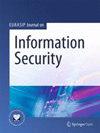FEDDBN-IDS: federated deep belief network-based wireless network intrusion detection system
IF 2.5
Q2 COMPUTER SCIENCE, INFORMATION SYSTEMS
引用次数: 0
Abstract
Over the last 20 years, Wi-Fi technology has advanced to the point where most modern devices are small and rely on Wi-Fi to access the internet. Wi-Fi network security is severely questioned since there is no physical barrier separating a wireless network from a wired network, and the security procedures in place are defenseless against a wide range of threats. This study set out to assess federated learning, a new technique, as a possible remedy for privacy issues and the high expense of data collecting in network attack detection. To detect and identify cyber threats, especially in Wi-Fi networks, the research presents FEDDBN-IDS, a revolutionary intrusion detection system (IDS) that makes use of deep belief networks (DBNs) inside a federated deep learning (FDL) framework. Every device has a pre-trained DBN with stacking restricted Boltzmann machines (RBM) to learn low-dimensional characteristics from unlabelled local and private data. Later, these models are combined by a central server using federated learning (FL) to create a global model. The whole model is then enhanced by the central server with fully linked SoftMax layers to form a supervised neural network, which is then trained using publicly accessible labeled AWID datasets. Our federated technique produces a high degree of classification accuracy, ranging from 88% to 98%, according to the results of our studies.FEDDBN-IDS:基于联合深度信念网络的无线网络入侵检测系统
在过去的 20 年里,Wi-Fi 技术已经发展到这样一个地步,即大多数现代设备都是小型的,依靠 Wi-Fi 接入互联网。由于无线网络与有线网络之间没有物理屏障,现有的安全程序无法抵御各种威胁,Wi-Fi 网络的安全性受到严重质疑。本研究旨在评估联合学习这种新技术,以解决网络攻击检测中的隐私问题和高昂的数据收集费用。为了检测和识别网络威胁,尤其是 Wi-Fi 网络中的网络威胁,该研究提出了 FEDDBN-IDS,这是一种革命性的入侵检测系统(IDS),在联合深度学习(FDL)框架内利用深度信念网络(DBN)。每台设备都有一个预先训练好的 DBN,通过堆叠受限玻尔兹曼机(RBM)从未标明的本地数据和私人数据中学习低维特征。随后,中央服务器使用联合学习(FL)将这些模型组合起来,创建一个全局模型。然后,中央服务器通过完全链接的 SoftMax 层对整个模型进行增强,形成一个监督神经网络,然后使用可公开访问的标记 AWID 数据集对其进行训练。根据我们的研究结果,我们的联合技术产生了很高的分类准确率,从 88% 到 98% 不等。
本文章由计算机程序翻译,如有差异,请以英文原文为准。
求助全文
约1分钟内获得全文
求助全文
来源期刊

EURASIP Journal on Information Security
COMPUTER SCIENCE, INFORMATION SYSTEMS-
CiteScore
8.80
自引率
0.00%
发文量
6
审稿时长
13 weeks
期刊介绍:
The overall goal of the EURASIP Journal on Information Security, sponsored by the European Association for Signal Processing (EURASIP), is to bring together researchers and practitioners dealing with the general field of information security, with a particular emphasis on the use of signal processing tools in adversarial environments. As such, it addresses all works whereby security is achieved through a combination of techniques from cryptography, computer security, machine learning and multimedia signal processing. Application domains lie, for example, in secure storage, retrieval and tracking of multimedia data, secure outsourcing of computations, forgery detection of multimedia data, or secure use of biometrics. The journal also welcomes survey papers that give the reader a gentle introduction to one of the topics covered as well as papers that report large-scale experimental evaluations of existing techniques. Pure cryptographic papers are outside the scope of the journal. Topics relevant to the journal include, but are not limited to: • Multimedia security primitives (such digital watermarking, perceptual hashing, multimedia authentictaion) • Steganography and Steganalysis • Fingerprinting and traitor tracing • Joint signal processing and encryption, signal processing in the encrypted domain, applied cryptography • Biometrics (fusion, multimodal biometrics, protocols, security issues) • Digital forensics • Multimedia signal processing approaches tailored towards adversarial environments • Machine learning in adversarial environments • Digital Rights Management • Network security (such as physical layer security, intrusion detection) • Hardware security, Physical Unclonable Functions • Privacy-Enhancing Technologies for multimedia data • Private data analysis, security in outsourced computations, cloud privacy
 求助内容:
求助内容: 应助结果提醒方式:
应助结果提醒方式:


